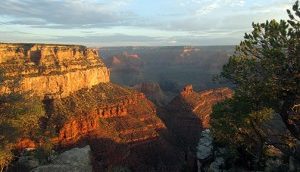I recently spent five days at the rim of the Grand Canyon. On four of the five days I hiked into the canyon on different trails. The experience was significantly different from mountain hiking, which is one of my favorite activities. I found that hiking into the Grand Canyon provided a profound disconnection from the numbing aspects of daily existence and really helped to reset all of my senses.
When I returned from vacation I felt recalibrated in a very positive way, even more so than I usually do after a hiking vacation. As I analyzed my experiences I realized that there are unique aspects to canyon hiking that make the experience particularly powerful.
The Grand Canyon is carved into a high plateau. When you begin your hike into the canyon, you very quickly lose all visual contact with the world above the rim. You enter into a separate zone of light, sound, and climate. This is different from mountain hiking, where you typically maintain visual contact with your starting point, at least for some time.
Disconnected from the world above the canyon, you find that your sense of space and time is profoundly altered. As you switch back on your descent you pass through different layers of the earth’s history. Each era forms a different color and texture on the canyon walls. You engage in a sort of time travel that takes you back 2 billion years by the time you reach the level of the Colorado River.
Set against this is the profound beauty of the passage of a single day in the canyon. Every few minutes from sunrise to sunset, the light changes so significantly on the different rock formations that from moment to moment there is a completely different world that you are viewing. This makes you intensely aware of the beauty and significance of each moment so that the passage of time seems to elongate.
A third measure of time is the regular sound of your footsteps as you make your way down the steep and rocky trails. You mark time with your steps against the very fluid sense of time created by the shifting light across the canyon and the expanded time of the two billion years that the walls of the canyon mark.
The three versions of time make our puny attempts to measure and control it seem trivial. For an individual like myself, who is used to an urban environment that is geared to extreme productivity, it is liberating to experience this expansion of time.

View from Kaibab Trail
The Grand Canyon also extends your sense of space. The vistas are so immense that you lose your ability to measure space in the usual way. It seems pointless to even attempt to measure the distance between the north and south rim; because they are beyond comprehension. The visual references that we use in our day-to-day experience to measure space don’t seem to work here.
It is only when you hike down into the canyon that you really understand just how puny you are. Rock formations that seem close when viewed from the perspective of the rim reveal the truth as you hike toward them. They are very far away and never seem to get closer, even after several hours of hiking. They exist in their own space that is separate from that of the hiker.
One of the paradoxes of the Grand Canyon is that it is remarkably photogenic, but somehow the experience of viewing it resists being captured in a photograph. Even an amateur photographer like me can obtain extraordinary images, but they only give a hint of what it is like to hike into the canyon. When you hike into the canyon you enter an immense space that seems beyond our usual concept of dimension. The deeper you go into the canyon, the more it pulls you into its space, so that you become a part of it. The ego-driven aspects of daily existence become increasingly unimportant, and you realize that you are a part of something much greater that is beyond our capability of description.




